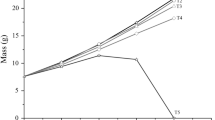Abstract
A 70-day feeding trial was conducted to evaluate the suitability of recycled food wastes [food industry waste (FIW) and soy sauce waste (SSW)] as protein sources in the diet of Oreochromis niloticus fry. Diets were formulated that contained 0 and 20–22%, respectively, recycled food wastes, namely D1 (0% recycled food waste), D2 (20% FIW), D3 (10% FIW and SSW, respectively), D4 (20% FIW and tryptophan), and D5 (22% SSW). Although feed efficiency, net protein retention, and protein efficiency were not significantly different among fish on the different diets (p > 0.05), those on D3 had a better growth performance than the controls (D1). Fish fed diet D4 (tryptophan supplement) had a higher final weight gain than those fed D2, in addition to the other growth parameters, but these differences were not significant (p > 0.05), with the exception of total feed intake. D1 produced fish with higher carcass protein, while fish fed on D3 had the highest lipid content. There was no significant difference between groups in terms of carcass moisture and ash contents. These findings show that the proper combination of recycled food waste is suitable for use in the production of fish feed and may ultimately result in reductions in the level of fishmeal in aquafeeds.

Similar content being viewed by others
References
Fontainhas-Fernandes A, Gomes E, Reis-Henriques MA, Coimbra J (1999) Replacement of fish meal by plant proteins in the diet of Nile tilapia: digestibility and growth performance. Aquac Int 7:57–67
Fasakin EA, Balogun AM, Fasuru BE (1999) Use of duckweed, Spirodela polyrrhiza L. Schleiden, as a protein, feedstuff in practical diets for tilapia, Oreochromis niloticus L. Aquac Res 30:313–318
Ali A, Al-Asgah NA, Al-Ogaily SM, Ali S (2003) Effect of feeding different levels of alfalfa meal on the growth performance and body composition of Nile tilapia (Oreochromis niloticus) fingerlings. Asian Fish Sci 16:59–67
El-Sayed A-FM (1999) Alternative dietary protein sources for farmed tilapia, Oreochromis spp. Aquaculture 179:149–168
Richter N, Siddhuraju P, Becker K (2003) Evaluation of nutritional quality of moringa (Moringa oleifera Lam.) leaves as an alternative protein source for Nile tilapia (Oreochromis niloticus L.). Aquaculture 217:599–611
Food and Agriculture Organization (FAO) of the United Nations (2003) Review of the state of the world agriculture. FAO Fisheries Circular 886. FAO, Rome
Gonzales JM, Hutson AH, Rosinski ME, Wu YV, Powless TF, Brown PB (2007) Evaluation of fish meal—free diets for first feeding Nile tilapia, Oreochromis niloticus. J Appl Aquac 19(3):89–99
National Research Council (NRC) (1993) Nutrient requirements of fish. National Academy Press, Washington D.C.
Lu J, Yoshizaki G, Sakai K, Takeuchi T (2002) Acceptability of raw Spirulina platensis by larval tilapia Oreochromis niloticus. Fish Sci 68:51–58
Takeuchi T (1988) Laboratory work—chemical evaluation of dietary nutrients. In: Watanabe T (ed) Fish nutrition and marine culture. Japan International Cooperation Agency, Tokyo, pp 179–233
Folch J, Lee M, Sloane-Stanley GH (1957) A simple method for the isolation and purification of total lipids from animal tissues. J Biol Chem 226:497–509
Simpson RJ, Neuberger MR, Liu TY (1979) Complete amino acid analysis of proteins from a single hydrolysate. J Biol Chem 251:1936–1940
Kawashima T (2002) The use of food waste as a protein source for animal feed—current status and technological development in Japan. In: FAO (ed) Animal production and health: Expert Consultation and Workshop Bangkok. FAO, Rome, pp 303–309
Santiago CB, Lovell RT (1988) Amino acid requirements for growth of Nile tilapia. J Nutr 118:1540–1546
Takeuchi T (1997) Essential fatty acid requirements of aquatic animals with emphasis on fish larvae and fingerlings. Rev Fish Sci 5:1–25
Fagbenro OA (1999) Comparative evaluation of heat-processed winged bean (Psophocarpus tetragonolobus) meals as partial replacement for fishmeal in diets for the African catfish (Clarias gariepinus). Aquaculture 170:297–305
Francis G, Makkar HPS, Becker K (2001) Antinutritional factors present in plant-derived alternate fish feed ingredients and their effects in fish. Aquaculture 119:197–227
Solomon SG, Tiamiyu LO, Agaba UJ (2007) Effect of feeding different grain sources on the growth performance and body composition of tilapia (Oreochromis niloticus) fingerlings fed in outdoor hapas. Pak J Nutr 6:271–275
Siddhuraju P, Becker K (2001) Preliminary nutritional evaluation of Mucuna seed meal (Mucuna pruriens var. utilis) in common carp (Cyprinus carpio L.): an assessment by growth performance and feed utilization. Aquaculture 196:105–123
Hano T, Hirata M, Takanashi H (2004) Approach to zero emission processes in food industry—case study for soy-sauce production process. Water Environ Tech 2:1–7
Anderson J, Jackson AJ, Matty AJ, Capper BS (1984) Effect of dietary carbohydrates and fibre on the tilapia Oreochromis niloticus (Linn.). Aquaculture 37:303–314
Wee KL, Wang SS (1987) Nutritive value of Leucaena leaf meal in pelleted feed for Nile tilapia. Aquaculture 62:97–108
Takeuchi T, Satoh S, Watanabe T (1983) Requirement of Tilapia nilotica for essential fatty acids. Nippon Suisan Gakkaishi 49:1127–1134
Acknowledgments
This study was carried out with the financial support provided by a Grant-in-Aid for Scientific Research (A) from Japan Society for the Promotion of Science (No. 20248021).
Author information
Authors and Affiliations
Corresponding author
Rights and permissions
About this article
Cite this article
Bake, G.G., Endo, M., Akimoto, A. et al. Evaluation of recycled food waste as a partial replacement of fishmeal in diets for the initial feeding of Nile tilapia Oreochromis niloticus . Fish Sci 75, 1275–1283 (2009). https://doi.org/10.1007/s12562-009-0133-x
Received:
Accepted:
Published:
Issue Date:
DOI: https://doi.org/10.1007/s12562-009-0133-x




